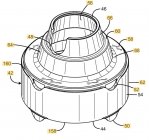Up front, I am not going to reveal the make of the suppressor so that we can keep the discussion on what and how?
This is a 9mm suppressor with a total of 11 baffles. It is attached to a PCC via a 3-lug adapter. Now when you ask how the end cap strike can happen, you will get question about the barrel, the 3-lug adapter, how it is fitted to the barrel, and how the suppressor was mounted.
I am going to say upfront that the problem is likely only in the suppressor. The reason is despite the end cap strike, NONE of the 11 baffles were damaged – ZERO.
If you look at the hole dimensions, a 9mm bullet is 0.3545” in diameter. On average, the baffle holes were between 0.4010” to 0.4040” in diameter, so there is 46 to 49 thousands leeway over the bullet. The end cap undamaged part had a diameter of 0.4135 so a 59 thousands leeway. Where the bullet skin and distorted the end cap, the hole had a diameter of 120 thousands.
So the question is how could a bullet travel past 11 baffles and not damage them but hit the end cap?
I can tell you that this suppressor had only about 150 rounds through it. The first 50 rounds, no damage anywhere. Next 50 I got a slight skim on the end cap. The last 50, I got enough of a it to expand the cap by 61 thousands.
Now if we look at the baffles, I found that they are of a asymmetric design with a keyhole on one side (see attached image from web) . My question is could gas associated with this keyhole push the bullet sideways as it is coming out of the end cap to cause the end cap strike? I cannot think of any other way that a bullet can travel past 11 tighter baffle with no hits but hit a larger hole at the end of the suppressor?
. My question is could gas associated with this keyhole push the bullet sideways as it is coming out of the end cap to cause the end cap strike? I cannot think of any other way that a bullet can travel past 11 tighter baffle with no hits but hit a larger hole at the end of the suppressor?
This is a 9mm suppressor with a total of 11 baffles. It is attached to a PCC via a 3-lug adapter. Now when you ask how the end cap strike can happen, you will get question about the barrel, the 3-lug adapter, how it is fitted to the barrel, and how the suppressor was mounted.
I am going to say upfront that the problem is likely only in the suppressor. The reason is despite the end cap strike, NONE of the 11 baffles were damaged – ZERO.
If you look at the hole dimensions, a 9mm bullet is 0.3545” in diameter. On average, the baffle holes were between 0.4010” to 0.4040” in diameter, so there is 46 to 49 thousands leeway over the bullet. The end cap undamaged part had a diameter of 0.4135 so a 59 thousands leeway. Where the bullet skin and distorted the end cap, the hole had a diameter of 120 thousands.
So the question is how could a bullet travel past 11 baffles and not damage them but hit the end cap?
I can tell you that this suppressor had only about 150 rounds through it. The first 50 rounds, no damage anywhere. Next 50 I got a slight skim on the end cap. The last 50, I got enough of a it to expand the cap by 61 thousands.
Now if we look at the baffles, I found that they are of a asymmetric design with a keyhole on one side (see attached image from web)
 . My question is could gas associated with this keyhole push the bullet sideways as it is coming out of the end cap to cause the end cap strike? I cannot think of any other way that a bullet can travel past 11 tighter baffle with no hits but hit a larger hole at the end of the suppressor?
. My question is could gas associated with this keyhole push the bullet sideways as it is coming out of the end cap to cause the end cap strike? I cannot think of any other way that a bullet can travel past 11 tighter baffle with no hits but hit a larger hole at the end of the suppressor?









